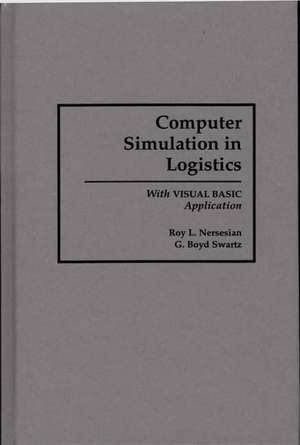Computer Simulation in Logistics: With Visual Basic Application
Autor Roy Nersesian, G. Boyd Swartzen Limba Engleză Hardback – 19 aug 1996 – vârsta până la 17 ani
Preț: 461.77 lei
Preț vechi: 608.88 lei
-24% Nou
Puncte Express: 693
Preț estimativ în valută:
88.40€ • 91.89$ • 73.29£
88.40€ • 91.89$ • 73.29£
Carte tipărită la comandă
Livrare economică 05-19 februarie 25
Preluare comenzi: 021 569.72.76
Specificații
ISBN-13: 9780899309859
ISBN-10: 0899309852
Pagini: 264
Dimensiuni: 156 x 235 x 19 mm
Greutate: 0.51 kg
Editura: Bloomsbury Publishing
Colecția Praeger
Locul publicării:New York, United States
ISBN-10: 0899309852
Pagini: 264
Dimensiuni: 156 x 235 x 19 mm
Greutate: 0.51 kg
Editura: Bloomsbury Publishing
Colecția Praeger
Locul publicării:New York, United States
Notă biografică
ROY L. NERSESIAN is Associate Professor in the Management Department at Monmouth University, New Jersey, and a maritime logistics consultant. He holds degrees in physics and business from Rensselaer Polytechnic Institute and the Harvard Business School. His previous Quorum books include Computer Simulation in Business Decision Making (1989), Corporate Planning, Human Behavior, and Computer Simulation (1990), and Computer Simulation in Financial Risk Management (1991).G. BOYD SWARTZ is Professor of Mathematics and Chair of the Mathematics Department at Monmouth University. He holds advanced degrees in electrical engineering and mathematics and is also a consultant to government, business, and education on matters involving computer simulations.
Cuprins
IntroductionThe Normality of ThingsWhen to Reorder and How Much?Determining Warehouse CapacityHow Many Warehouse Docks?How Many Trucks Should be Owned?Tankers Serving a PipelineSelecting AircraftJust-In-Case Inventory for DeliveryPush ManufacturingPull ManufacturingCombining WarehousesFactory InventoryThe Economic Run LengthSiting an Ambulance StationSelected BibliographyIndex









